7th Tcl/Tk Conference, 2000
[Technical Program]
| Pp. 1–10 of the Proceedings |  |
Rapid CORBA Server Development in Tcl: A Case Study
Rapid CORBA Server Development in Tcl: A Case Study
Jason Brazile and Andrej Vckovski
Netcetera AG
Zurich, Switzerland
A large Swiss bank needed to collect, combine, process, and distribute
financial market data from various 3rd party data sources to a large
number of internal and external clients -- the typical integration task
at which scripting languages excel. The bank uses an implementation of
CORBA as their standard enterprise-wide middleware for distributed
applications. We describe how we designed and built a Tcl/C++ transport
framework which allowed us to develop the "kernel" of this server
application entirely in Tcl, yet support CORBA as the primary interface
to the server. We further describe how this framework allows a small
development team to rapidly implement changes and enhancements to the
server and its external interface, while automatically generating the
corresponding changes that are needed for the CORBA interface.
Additionally, we show how we were able to automatically generate code
to create new tcl commands that make use of the same, generated,
Tcl/C++ marshalling routines in order to develop a CORBA client in Tcl,
which is used to regression test the server, when full end-to-end
testing is needed.
In his keynote address at the 1999 USENIX Technical Conference
[1], John Ousterhout argued that typical programming projects
are shifting away from large stand-alone applications and moving toward
integration applications, (sometimes also referred to as
mega-programming [2]). The importance of these
applications, he argued, lies not in providing fundamental new features
as much as in the ability to coordinate and extend existing
applications -- exactly the tasks at which scripting languages excel.
He argued that many things taken for granted today, such as strong
typing and inheritance, may not make sense in most future
applications.
As we analyzed our customers requirements for for their strategic new
mission critical server application, we found ourselves in agreement
with this basic philosophy. It became clear that our customer needed to
primarily integrate information coming in from several already existing
applications -- combining, merging, and formatting everything into a
unified view. This result would need to be exported through certain
transport mechanisms -- initially the most important being CORBA.
However, even at the earliest stages, other access channels (e.g. XML)
were planned.
Upon noting CORBA as a requirement, many software architects might
automatically dismiss the idea of designing the core application
functionality in a scripting language such as Tcl, even though it is
not without precedent [3], [4]. However, we were
further encouraged to follow our core-as-scripting-language idea when
we realized that our application needed to be prepared for the
following:

Simplified Server Overview
- Frequent changes to the interfaces to external applications
- Rapid integration of new data sources (i.e., new applications)
- Frequent changes to the access requirements requested by
clients (i.e., IDL changes)
- Rapid implementation of new features requested by marketing
analysts
- Possible implementation of different data access channels
(e.g. XML) as some move out of favor, and others move in
It is worth mentioning that this server application is mission critical
in the sense that some client applications planned to present the data
on the Internet (i.e., they are highly visible) for tasks such as
financial planning, on-line banking, and as a financial news source. An
even greater sense of urgency was placed upon us when we learned that
some of the client applications were planned to go online within weeks
of our planned initial release -- many of these applications with
budgets 10 times larger than ours.
However, these robustness and flexibility requirements merely further
increased our resolve to attempt to develop as much as possible in
a scripting language and as little as possible in traditional CORBA
server implementation languages.
Our goal then became to design and implement a flexible platform
that performed these integration tasks -- providing data in a
canonical form and otherwise acting as mediator to a large and
growing set of heterogeneous data sources with different manners of
access to the same interfaces.
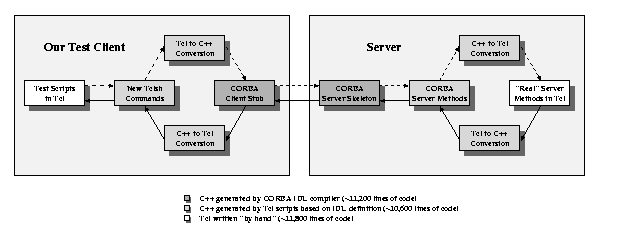
Data Flow (CORBA Case)
The overall feature that we were targetting was a one-to-one mapping
between the methods defined by the CORBA IDL (Interface Definition
Language) specification and the Tcl procedures that would implement
these specifications. To illustrate this with an example, consider
the following IDL definition for a method called foo::square():
interface foo {
int square (
in int a,
out int b
);
}
We would like to define a Tcl procedure to implement this method that
looks like this:
proc foo::square {a vb} {
upvar $vb b
set b [expr $a * $a]
}
The general idea would be that a CORBA request coming in to the
server would get translated to a corresponding Tcl command. Then
a Tcl interpreter would be invoked that first "sourced" the Tcl
implementations of these commands, and then "eval'd" the Tcl
command that was composed. It would then translate the Tcl results
of that evaluation back into CORBA objects which are returned to
the client.
With this design, the framework would then consist of a CORBA server
with an embedded Tcl interpreter that would source the "real
methods" implemented as procedures in a Tcl script "kernel".
However, in addition, we wanted to extend a Tcl shell that would serve
as a CORBA client which would contain Tcl commands that also had a
one-to-one mapping to the methods defined in the IDL. The function
signatures of these new commands would look identical to the function
signatures in the procedures in the Tcl "kernel". This would allow
for natural looking Tcl code as in the following example:
% foo::square 4 result
% set result
16
One of the best characteristics of this architecture is that test
scripts could be written in Tcl that could be run either on the CORBA
Tcl client or in a "shortcut" path which completely bypasses any
middleware infrastructure by making direct access to the Tcl "kernel"
procedures. This feature allowed much of the server functionality to be
able to be developed on a stand-alone UNIX laptop which did not have a
CORBA development environment.
To summarize, this design approach would give us the following
benefits:
- The ability to begin development of the core methods in
Tcl completely independent of, and in parallel to, the development
of CORBA support.
- The ability to write test scripts in Tcl
- The ability to develop all the core programming logic in a
rapid turnaround scripting language, rather than a lower level, strictly
typed, compiled language.
- If different transport paths are required, only a new transport
layer would need to be written and the same "kernel" could be used to
give identical functionality with maximal code reuse.
After implementing a small prototype to test the feasibility of this
approach, it became clear that a large amount of the CORBA transport
layer code was regular enough that it could be automatically
generated -- again by scripts written in Tcl.
The full data path and amount of automatic code generation we ended
up with is shown in Figure 1.
At the end of the design phase, we concluded that the key aspects of
this architecture required the following components to be written:
- CORBA Language mappings for Tcl
- Methods/Operations implemented in Tcl
- Automatic generation of the marshalling code based on IDL
definitions
- Automatic generation of client side tcl commands based on IDL
definitions
One of the key issues to resolve was how to map CORBA objects to
typeless Tcl strings. In the worst case, this could be done by
defining every C++ value to be a Tcl list containing two elements
-- the value and its type. Then, a lookup table could be constructed
to store the types and whatever needed semantics might be associated
with it in order to manipulate or access objects of that type.
Fortunately, however, a much simpler strategy was possible in this
case. We ended up using a mapping similar to that used by Pilhofer
in Tclmico [3]. We started by looking at all of the
possible CORBA types that are made available -- the basic data types
like boolean, integer, and floats, as well as the compound data
types such as structures, arrays, unions, and sequences. We also
wanted to be able to map Tcl exceptions to CORBA exceptions.
It is fairly straightforward to map the common types such as a
structure. For example, an object of type RequestContext
which can be defined like this:
typedef sequence <string> Profile;
struct rc {
int sessionId,
string application,
string lang,
Profile profile,
string user,
};
typedef rc RequestContext;
could become a Tcl list with the following representation:
set my_rc {-1 web-quotes ENGLISH \
{SWISS_REALTIME US_DELAYED} guest}
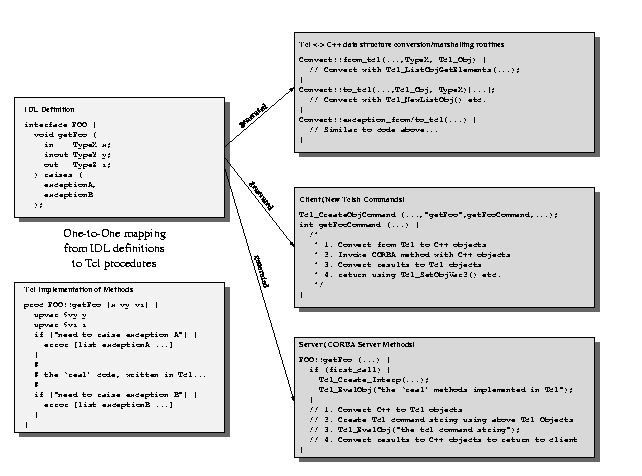
Automatic Generation of CORBA "Transport" Routines
Going from this Tcl list representation back to its corresponding
C++ object representation requires that we know the CORBA types of
each component. However, this is positionally implicit based on
the context of the procedure calls that use variables of these
types and the definitions of the procedures themselves as defined
in the IDL. In other words, when we know that something is the
first argument to method getMarketData and according to
our codification of the IDL, the first argument to method
getMarketData is of type RequestContext, then we
just pass this list to a routine that converts a list (which in
this case, itself contains a list) to a C++ object of type
RequestContext. This can be done statically, because we
always know at compile time which procedures are being called and
what types their arguments are because of their position. That is,
except in the case of translating "exceptions", which is described
below.
To take a quick glance at some of the other types, a variable whose
type is a union can be mapped to a two-element list where the
first element is the discriminator and the second is the corresponding
value. The sequence and enum types are simply mapped
to a list.
Perhaps the trickiest mapping to come up with was a mapping for
exceptions. A Tcl exception (as thrown by the error
command) allows only one string/list as an argument. However, for
our purposes, we needed to know both what exception occurred
(i.e., an exception type) and an additional exception-specific
object. The problem of course is that this second object's "shape"
can be different depending on what type of exception is to be
thrown.
One interesting point to be made is that by having a general mapping
mechanism for Tcl exceptions, our application can catch not only
application specific exceptions that we throw ourselves, but also
the standard Tcl exceptions that may occur due to attempted undefined
variable access, for example.
We imposed a convention upon our own code whereby our application
specific exception objects would have a certain well-defined structure,
so that we could then differentiate them from Tcl exceptions which get
mapped to an "Internal Error" exception with a Tcl backtrace, rather
than merely crashing the application.
This turned out to be the one case where we needed to determine
type information dynamically in order to be able to do the CORBA
language mappings. The code is structured as follows:
if (Tcl_EvalObj() == TCL_ERROR) {
if (/* has special shape */) {
type = Tcl_GetStringFromObj();
ex_type = type_to_enum(type);
switch (ex_type) {
case exceptionA:
// now we know the type
Convert::from_tcl(...);
THROW(exceptionA, ...);
case exceptionB:
// now we know the type
Convert::from_tcl(...);
THROW(exceptionB, ...);
}
} else {
// Tcl Exception
THROW(internal, ...);
}
}
Raising an exception from within our Tcl code looks like this:
if {$some_exceptional_condition} {
error {badParam \
{431 "FOO parameter expected"}}
}
One of the most important features of the framework is that a large
portion of the low-level (e.g. non-Tcl) code can be automatically
generated, (Figure 2). This is good not only for quick response
to changes in requirements, but also in our level of confidence in
the server's robustness. Once we developed a logical, regular
pattern for use in code generation, and we measure and test that
code for relative correctness and memory leaks etc., then we have
a high degree of trust in code that is generated from the same
patterns in future enhancements. And as a practical matter, we feel
confident that if the generated code checks return values and
correctly handles error conditions in one case, it will also
correctly handle them in all similar cases.
To recap, our design revealed that the following components
could be generated automatically:
- Marshalling code from/to Tcl
- Implementation of new Tcl commands for a Tcl interpreter
used as a CORBA client
- CORBA server skeletons which translate a method to a Tcl
command, "eval" the Tcl "kernel", and translate the result
back.
We used our hand-written prototype implementation as a model for the
generated C/C++ code. There is nothing particularly noteworthy about
the Tcl scripts which generated the C/C++ code. It was mostly a matter
of template textual substitution.
It should be pointed out that the code generation scripts are not
necessarily general purpose. Code was only written to generate the
types and cases that appeared in our server IDL definition. As new
methods and data types were added to the IDL definition, additional
lines of code generation code occasionally had to be written. On the
other hand, none of these additions so far have caused any fundamental
change in the general code generation technique that is used.
It should further be pointed out that the code is not generated
directly from the IDL definition files, but rather from
a "pre-parsed" intermediate representation of the information
that is represented in the IDL definition files.
The IONA Orbix CORBA product provides a code generation toolkit
[5] which exposes a pre-parsed representation of IDL files
through Tcl data structures and accessor procedures by way of a
built-in Tcl interpreter. This would be an efficacious approach for
our application, but at the time of implementation, we were limited to
a proprietary CORBA environment which therefore required our own ad hoc
solution.
Our simplistic intermediate file representation was designed so that
it can be used in a Tcl code generation script by merely "eval'ing"
it. We wanted to defer the difficult problem of parsing the IDL files
themselves in the hopes that an automatic solution, such as that
provided by Orbix, would eventually become available. In the meantime,
making these changes to our intermediate file "by hand", whenever the
IDL file has changed, has not required a significant effort.
4.1 Marshalling
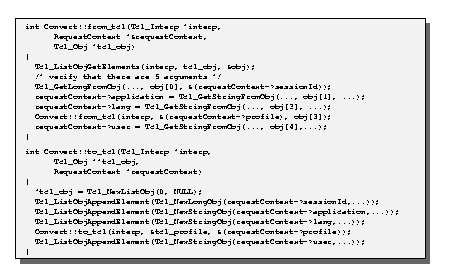
Simplified Data Marshalling code (CORBA Case)
The marshalling code was built around the idea of having two essential
polymorphic conversion methods -- Convert::from_tcl() which
would take a Tcl object representing a list structure as input and
produce a CORBA object (which may be composed of CORBA sub-objects)
as output -- and Convert::to_tcl() which would go the
opposite direction. The types of the arguments to these routines
would determine which instance of the conversion routine would be
called.
It was also decided that these routines would recursively call
themselves to process each subcomponent that might need to be
converted, thus eliminating code duplication.
A representative pair of automatically generated conversion methods
is shown for our RequestContext object in Figure 3. Notice
that the fourth member of the structure is a non-primitive object
which leads to a recursive call to Convert::from_tcl.
4.2 Server
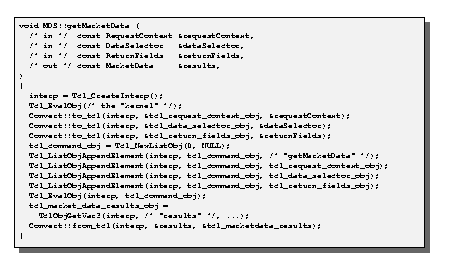
Simplified Generated Server code (CORBA Case)
On the server side, the IDL compiler generates server skeletons
(i.e. procedure stubs) for the methods that are defined in the IDL.
However, our Tcl script subsumes this behavior by generating its
own completed server skeletons which merely rely on there being a
correspondingly named Tcl procedure in the Tcl "kernel" that it
can "eval".
An example of generated server code is shown in Figure 4.
It might be worth mentioning that the Tcl "kernel" is packaged as a
monolithic static string in a shared object so that it appears as a
standard looking shared library. This is advantageous not only for
simpler code distribution, but has a higher management acceptance
factor than scripts as text files.
4.3 Client
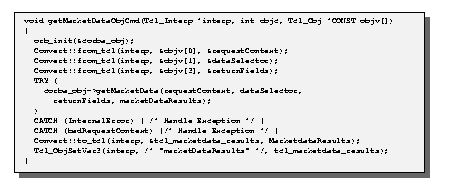
Simplified Generated Client code (CORBA Case)
On the client side, much of the code is analogous to what is required
for the server. The arguments need to be converted, the relevant
method in the new implementation language needs to be called, then
the output from the result needs to be translated back.
An example of generated client code is shown in Figure 5.
By far, the greatest advantage in testing was the ability to write
tests in Tcl and to merely source our "kernel" implementations of
the methods being tested. A quick change could be made and the
method in question could be re-"sourced" with rapid turnaround.
Also, with this method, the important code could be written without
the need for a CORBA development infrastructure or even the need
to run separate server/client processes.
Once we had a CORBA Tcl client, we were able to reuse the same
testing scripts we wrote during development to do end-to-end testing
across the CORBA channel. This even allowed other development groups
who were writing CORBA-based client applications to our server, to
use our CORBA Tcl client in order to do quick exploration and
cross-checking of the interface whenever they ran into difficulties.
An example test script looks like this:
% set requestContext {$sessionID \
$applicationID ENGLISH \
{DELAYED} $userId}
% set dataSelector {BYCONSTRAINTS \
{{} {"US Dollars"} \
{"Swiss Exchange"}}}
% set returnFields {BYFIELDNAME \
{ID CURRENT_PRICE HIGH_PRICE}}
% getMarketData $requestContext \
$dataSelector $returnFields \
results
% puts $results
{ID 324598234 CURRENT_PRICE 45.5
HI_PRICE 48.25} {ID 43098234 ...}
In summary, with our CORBA-as-transport design, we were able to
achieve:
- Rapid development
- Robustness
- Ease of testing
- Rapid implementation of interface changes
- Development outside of huge support environment
- Reuse of useful tools in the OSF arena to integrate other
applications and leverage all of this even within a rigidly specified
middleware framework.
At least up to a certain point, performance was never a high-priority
requirement. However, it turned out not to be a problem either.
When performance problems were encountered, the largest gains were
achieved by adding caching at the Tcl "kernel" level to compensate
for slow data accesses to external applications.
The most unexpected benefit was the ease in providing an XML access
method to our Tcl "kernel" which obviously gives identical
semantics, results, and performance characteristics. We were able
to use many of the same code generation techniques to write automatic
XML to Tcl marshalling/unmarshalling code, which relies on exactly
the same pre-parsed intermediate representation of the IDL that
the CORBA transport layers uses.
We must admit that there was initial skepticism in the approach we
took, especially at the beginning of the project when so much effort
seemed to be needed in just building framework and code generation
tools which didn't lead directly to our tightly scheduled goal.
However, in the end we not only achieved our goal but were easily
able to adapt to even more change requests than anticipated, given
the high level of flexibility our system afforded. The IDL
specification has gone through 12 revisions since the application
was first launched in December 1998.
- Ousterhout, John, Integration Applications: The Next Frontier in
Programming, Keynote Address, 1999 USENIX Technical Conference,
Monterey, California, 1999.
- Wiederhold, Gio, Peter Wegner, and Stefano Ceri, Towards
Megaprogramming, Communications of the ACM, Vol.,35 No.11,
November 1992.
- Miller, Michael and Kareti, Srikumar, Using Tcl to Script CORBA
Interactions in a Distributed System, The Sixth Annual Tcl/Tk
Conference, San Diego, California, 1998.
- Pilhofer, Frank,
Tclmico -- A Tcl interface to the Mico ORB
- Orbix Code Generation Toolkit Programmer's Guide, IONA
Technologies PLC, Dublin, Ireland, February 1999.
| 